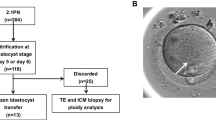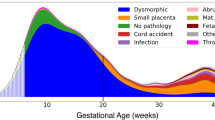Abstract
Purpose: To find an effective method to select embryos from ICSI with better chromosomal status when preimplantation-genetic-diagnosis (PGD) is not applied.
Methods: Several morpholological evaluations were done in same embryos. Embryos from ICSI were classified on day 1 according to pronuclear-nucleoli arrangement. On day 3, classification was done according to number, fragmentation, size and shape of cells. In some patients, embryos exhibiting good quality on day 3 (at least six regular blastomeres with cell fragmentation lower than 20%) were also submitted to PGD, irrespective to pronuclear-nucleoli morphology.
Results: Forty-two per cent of normally fertilized embryos showed pronuclear-nucleoli-good-morphology; from those, 86% were also classified as good quality on day 3. Good-quality embryos submitted to PGD have shown lower chromosomal abnormality rates when also classified as pronuclear-nucleoli-good-morphology.
Conclusions: Pronuclear-nucleoli morphology seems to be correlated with PGD results. This criterion may prove useful for pre-select embryos with normal chromosomal package when PGD is not applied.
Similar content being viewed by others
References
Scott LA, Smith S: The successful use of pronuclear embryo transfers the day following oocyte retrieval. Hum Reprod 1998;13:1003–1013
Tesarik J, Grecco E: The probability of abnormal preimplantation development can be predicted by a single static observation on pronuclear stage morphology. Hum Reprod 1999;14:1318–1323
Scott L, Alvero R, Leondires M, Miller B: The morphology of human pronuclear embryos is positively related to blastocyst development and implantation. Hum Reprod 2000;15:2394–2403
Roux C, Joanne C, Agnani G, Fromm M, Clavequin MC, Bressan JL: Morphometric parameters of living human in-vitro fertilization embryos: Importance of asynchronous division process. Hum Reprod 1995;10:1201–1207
Giorgetti C, Terriou P, Auquier P, Hans E, Spach JL, Salzmann J, Roulier R: Embryo score to predict implantation after in-vitro fertilization: Based on 957 single embryo transfers. Hum Reprod 1995;10:2427–2431
Cooperman AB, Selick CE, Grunfeld L, Sandler B, Bustillo M: Cumulative number and morphological score of embryos resulting in success: Realistic expectations from in vitro fertilization-embryo transfer. Fertil Steril 1995;64:88–92
Terriou P, Sapin C, Giorgetti C, Hans E, Spach JL, Roulier R: Embryo score is a better predictor of pregnancy than the number of transferred embryos or female age. Fertil Steril 2001;75:525–531
Fenwick J, Platteau P, Murdoch AP, Herbert M: Time from insemination to first cleavage predicts developmental competence of human preimplantation embryos in vitro. Hum Reprod 2002;17:407–412
Racowsky C: High rates of embryonic loss, yet high incidence of multiple births in human ART: Is this paradoxical? Theriogenology 2002;57:87–96
Braude P, Bolton V, Moore S: Human gene expression first occurs between the four- and eight-cell stages of preimplantation development. Nature 1988;332:459–461
Hardarson T, Caisander G, Sjögren A, Hanson C, Hamberger L, Lundin K: A morphological and chromosomal study of blastocysts developing from morphologically suboptimal human pre-embryos compared with control blastocysts. Hum Reprod 2003;18:399–407
Scott L. Pronuclear scoring as a predictor of embryo development. RBMOnline 2003; 6(2):201–214
Gardner DK, Schoolcraft WB, Wagley L, Schlenker T, Stevens J, Hesla J: A prospective randomized trial of blastocyst culture and transfer in in-vitro fertilization. Hum Reprod 1998;13:3434–3440
Huisman GJ, Fauser BC, Eijkemans MJ, Pieters MH: Implantation rates after in vitro fertilization and transfer of a maximum of two embryos that have undergone three to five days of culture. Fertil Steril 2000;73:117–122
Gianarolli L, Magli MC, Ferraretti AP, Fiorentino A, Garrisi J, Munne S: Preimplantation genetic diagnosis increases the implantation rate in human in vitro fertilization by avoiding the transfer of chromosomally abnormal embryos. Fertil Steril 1997;68:1128–1131
Magli MC, Jones GM, Gras L, Gianarolli L, Korman I, Trounson AO: Chromosome mosaicism in day + 3 aneuploid embryos that develop to morphologically normal blastocysts in vitro. Hum Reprod 2000;15:1781–1786
Behr B, Pool TB, Milki AA, Moore D, Gebhardt J, Dasig D: Preliminary clinical experience with human blastocyst development in vitro without co-culture. Hum Reprod 1999;14:454–457
Munné S, Alikani M, Tomkin G, Grifo J, Cohen J: Embryo morphology, developmental rates and maternal age are correlated with chromosome abnormalities. Fertil Steril 1995;64:382–391
Pellicer A, Rubio C, Vidal F, Minguez Y, Jiménez C, Egozcue J, Remohi J, Simon C: In vitro fertilization plus preimplantation genetic diagnosis in patients with recurrent miscarriage: An analysis of chromosome abnormalities in humam preimplantation embryos. Fertil Steril 1997;71:1033–1039
Palermo G, Joris H, Devroey P, Van Steiteghem AC: Pregnancies after intracytoplasmic sperm injection of single spermatozoon into an oocyte. Lancet 1992; 340:17–18
Munné S, Lee A, Rosenwaks Z, Grifo J, Cohen J: Diagnosis of major chromosome aneuploidies in human pre-implantation embryos. Hum Reprod 1993;8:2185–2191
Puissant F, Van Rysselberge M, Barlow P, Dewezw J, Leroy F: Embryo scoring as a prognostic tool in IVF treatment. Hum Reprod 1987;2:705–708
Jackson K, Ginsburg E, Hornstein M, Rein MS, Clarke RN: Multinucleation in normally fertilized embryos is associated with an accelerated ovulation induction response and lower implantation and pregnancies rates in vitro fertilization-embryo transfer cycles. Fertil Steril 1998;70:60–66
Pelinck MJ, De Vos M, Dekens M, Van der Elst J, Sutter P, Dhont M: Embryos cultured in vitro with multinucleated blastomeres have poor implantation potential in human in-vitro fertilization and intracytoplasmic sperm injection. Hum Reprod 1998;13:960–963
Land JA, Evers JLH: Risks and complications in assisted reproduction techniques: Report of an ESHRE consensus meeting. Hum Reprod 2003;18:455–457
Van Royen E, Mangelschots K, De Neubourg D, Valkenburg M, Van de Meerssche M, Rychaerti G, Eestermans W, Gerris J: Characterization of a top quality embryo, a sep towards single-embryo transfer. Hum Reprod 1999;14:2345–2349
Neubourg DD, Mangelschots K, Van Royen E, Vercruyssen M, Ryckaert G, Valkenburg M, Barudy-Vasquez J, Gerris J: Impact of patients choice for single embryo transfer of a top quality embryo versus double embryo transfer in the first IVF/ICSI cycle. Hum Reprod 2002;17:2621–2625
Rijnders PM, Jansen CAM: The predictive value of day + 3 embryo morphology regarding blastocyst formation, pregnancy and implantation rate after day 5 transfer following in-vitro fertilization or intracytoplasmic sperm injection. Hum Reprod 1998;13:2869–2873
Graham J, Han T, Porter R, Levy M, Stillman R, Tucker MJ: Day + 3 morphology is a poor predictor of blastocyst quality in extended culture. Fertil Steril 2000;74:495–497
Ludwig M, Schopper B, Al-Hasani S, Diedrich K: Clinical use of a pronuclear stage score following intracytoplasmic sperm injection: Impact on pregnancy rates under the conditions of the German embryo protection law. Hum Reprod 2000;15:325–329
Balaban B, Urman B, Isiklar A, Alatas C, Aksoy S, Mercan R, Muncu A, Nuhoglu A: The effect of pronuclear morphology on embryo quality parameters and blastocyst transfer outcome. Hum Reprod 2001;16:2357–2361
Demirel LC, Evirgen O, Aydos K, Unlu C: The impact of the source of spermatozoa used for ICSI on pronuclear morphology. Hum Reprod 2001;16:2327–2332
Tesarik J, Mendoza C, Greco E: Paternal effects acting during the first cell cycle of human preimplantation development after ICSI. Hum Reprod 2002;17:184–189
Rossi-Ferragut LM, Iacoenlli Jr A, Aoki T, Rocha CC, Medeiros ARC, Santos DR, Pasqualotto FF, Borges Jr. E: Zygote morphology scoring in male and female factor in ICSI cycles. Hum Reprod 2001a;16:O-109, 17th Annual Meeting
Rossi-Ferragut LM, Iaconelli Jr. A., Aoki T. Rocha CC, Santos DR, Pasqualotto FF, Borges Jr. E: Pronuclear Morphological features as a cumulative score to select embryos in ICSI (intracytoplasmic sperm injection) cycles according to sperm origin. J Assist Reprod Genet 2003;20:1–7
Rossi-Ferragut LM, Iacoenlli Jr. A, Rocha CC, Medeiros ARC, Aoki T, Borges Jr. E: Relationships between pronuclei and nucleoli morphology with the prognosis in intracytoplasmic sperm injection (ICSI) cycles. Fertil Steril 2001b;SI24:P-38, 57th Annual Meeting of the American Society for Reproductive Medicine
Sultan KM, Munne S, Palermo GD, Alikani M, Cohen J: Chromosomal status of unipronuclear human zygotes following in-vitro fertilization and intracytoplasmic sperm injection. Hum Reprod 1995;10:132–136
Staessen C, Van Steirteghem AC: The chromosomal constitution of embryos developing from abnormally fertilized oocytes after intracytoplasmic sperm injection and conventional in-vitro fertilization. Hum Reprod 1997;12:321–327
Hardy K, Martin KL, Leese HJ, Winston RM, Handyside AH: Human preimplantation development in vitro is not adversely affected by biopsy at the 8-cell stage. Hum Reprod 1990;5:708–714
Farah LMS, Joffe R, Rocha CC, Rossi-Ferragut LM, Santos J, Iaconelli Jr, Borges Jr E: Detection of numerical chromosome aberrations in preimplantation human embryos: Our experience. Reproduccion Humana 2001;1:26–31
Ziebe S, Petersen K, Lindenberg SG, Andersen A, Gabrielsen A, Andersen AN: Embryo morphology or cleavage stage: How to select the best embryos for transfer after in-vitro fertilization. Hum Reprod 1997;12:1545–1549
Leese HJ. Non-invasive methods for assessing embryos. Hum Reprod 1987;5:435–438
Gardner DK, Lane M: Culture and selection of a viable blastocysts: A feasible proposition for human IVF? Hum Reprod Update 1997;3:367–382
Gardner DK, Lane M, Stevens J, Schlenker T, Schoolcraft B: Blastocyst score affects implantation and pregnancy outcome: Towards a single blastocyst transfer. Fertil Steril 2000;73:1155–1158
Shapiro BS, Harris DC, Richter KS: Predictive value of 72-hour blastomere cell number on blastocyst development and success of subsequent transfer based on the degree of blastocyst development. Fertil Steril 2000;73:582–586
Sandalinas M, Sadowy S, Alikani M, Calderon C, Cohen J, Munne S: Developmantal ability of chromosomally abnormal embryos to develop to the blastocyst stage. Hum Reprod 2001;16:1954–1958
Gianarolli L, Magli MC, Ferraretti AP, Fortini D, Grieco N: Pronuclear morphology and chromosomal abnormalities as scoring criteria for embryo selection. Fertil Steril 2003;80:341–349
Steer CV, Mills CL, Tan SL, Campbell S, Edwards RG: The cumulative embryo score: A predictive embryo scoring technique to select the optimal number of embryos to transfer in an in-vitro fertilization and embryo transfer programme. Hum Reprod 1992;7:117–119
Fisch DJ, Rodriguez H, Ross R, Overby G, Sher G: The Graduated embryo score (GES) predicts blastocyst formation and pregnancy rate from cleavage-stage embryos. Hum Reprod 2001;16:1970–1975
Borges Jr E, Rossi-Ferragut LM: Prolonged culture. In Human Assisted Reproduction Book. BB Scheffer, J Remohi, J Garcia-Velasco, A Pellicer, C Simon (eds), Brazil, Atheneu Press, 2002, pp 177–188
Author information
Authors and Affiliations
Corresponding author
Rights and permissions
About this article
Cite this article
Borges, E., Rossi, L.M., Farah, L.M.S. et al. The impact of pronuclear orientation to select chromosomally normal embryos. J Assist Reprod Genet 22, 107–114 (2005). https://doi.org/10.1007/s10815-005-4874-x
Received:
Accepted:
Issue Date:
DOI: https://doi.org/10.1007/s10815-005-4874-x




